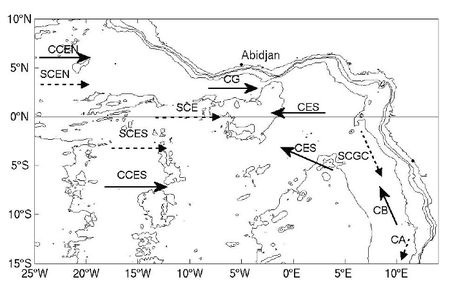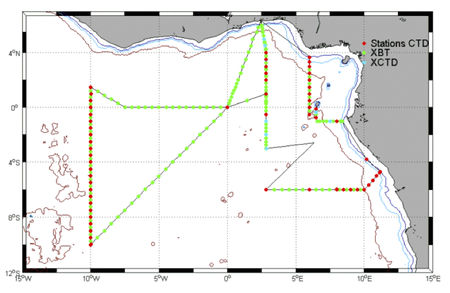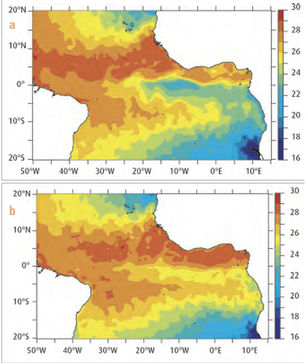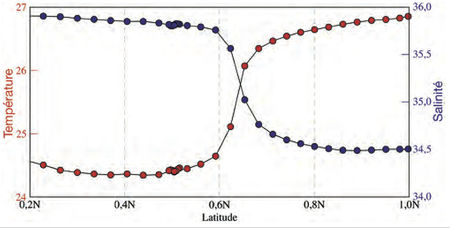The EGEE project (Gulf of Guinea climate and ocean circulation study, which is the oceanographic strand of the AMMA -African Monsoon Multidisciplinary Analyses program) general objective is to study variability in the upper layers of the Gulf of Guinea (GG). It emphasizes ocean-atmosphere interface exchanges, through joint use of in situ and satellite measurements and numerical model results, as well as sub-surface ocean circulation which greatly conditions the way surface layers evolve. To meet the program's aims, the six EGEE cruises are used to acquire in situ hydrological and current measurements in the upper layers of the ocean as well as meteorological measurements. They also allow the maintenance of the PIRATA ATLAS buoy network which is also needed for studies on air-sea exchanges in the Gulf of Guinea. The overall project is AMMA (African Monsoon Multidisciplinary Analyses).
Ocean Circulation and Climate in the Gulf of Guinea
by B. Bourlès *(a) and G. Caniaux (b)
* Corresponding author : Bernard Bourlès
(a) : IRD de Bretagne, Plouzané FRANCE
(b) : CNRM Météo-France, Toulouse FRANCE
A better knowledge of the importance and the impact of the Gulf of Guinea on the climate of neighboring regions, especially on the African monsoon, will be possible only through a better understanding of the ocean circulation in this region, which affects the encountered surface conditions and thus air/sea exchanges. In this context, the EGEE project has focused on the variability of the upper ocean circulation of the Gulf of Guinea, with a particular focus on the importance of exchanges at the ocean-atmosphere interface and ocean circulation subsurface which largely determines the evolution of the surface layers.
EGEE cruises during years 2005-2007 have enabled huge advances in the knowledge of ocean-atmosphere interactions in the Equatorial Atlantic basin, and the coupling between the sea surface temperature anomalies in this region and the African monsoon. Three main actors have clearly been identified in the strengthening of the African monsoon flow and in the northwards moving of seasonal precipitations : the St. Helena’s anticyclone, the Atlantic cold tongue and the Equatorial Atlantic Front.
The EGEE program was the oceanographic part of the first component now completed of the AMMA (Multidisciplinary Analyses of the African Monsoon) international program. It was funded in 2002 and 2003 by PATOM and PNEDC national programs, and received additional support from the GMMC (in addition to AMMA organizations) for the establishment of six unprecedented cruises from 2005 to 2007 during the three intensive years of the project in the Gulf of Guinea.
Scientific context
The oceanic circulation and its variability in the oriental part of the Tropical Atlantic Ocean, and their links with the climate of neighboring regions, are still paradoxically few known. Yet it is already established that the intensity of the monsoon and rainfalls and their spatial distribution over the West Africa largely depend on the meridional gradients of energy between the Atlantic Ocean (especially the Gulf of Guinea) and continental regions (West Africa). These gradients of boundary layer are determined by the variables encountered at the surface, that are continental (albedo, vegetation, soil moisture) or oceanic parameters (sea surface temperature).
Figure 1 : Diagram of the surface and sub-surface circulation in the east-equatorial Atlantic and the Gulf of Guinea. Surface Currents (solid lines with arrows) : North-Equatorial Counter Current (CCEN) ; Guinea Current (CG) ; South Equatorial Counter Current (CCES) ; South Equatorial Current (CES) ; Benguela Current (CB). Sub-surface Currents (dashed arrows) : North Equatorial Under Current (CSEN) ; Equatorial Under Current (SCE) ; South Equatorial Under Current (SCES) ; Gabon-Congo Under Current (SCGC) ; Angola Current (CA).
Since years 1970-1980, numerous observations obtained in the eastern basin of the tropical Atlantic helped to describe the set of currents and hydrological characteristics of the upper layers (Peterson et Stramma 1991; Wacongne et Piton, 1992 , Arhan et al., 1998; Stramma et England, 1999). The equatorial Atlantic is characterized by a complex system of strong currents (Fig. 1), which are nearby in latitude (as the Guinea Current at 3-4°N and the opposite South Equatorial Current between 4°S and 2°N ) and vertically stacked, like the South Equatorial Current (CES) overlying the Equatorial Undercurrent (SCE) in the first hundred meters (Kolodziejczyk et al., 2009). This ocean is stratified and heterogeneous, with thin mixed layers at the equator (10-20 m) deepening on both sides (about 40 m at 4°S).
The origin of the seasonal cooling affecting the East Equatorial Atlantic, the relationship between SST anomalies and precipitation anomalies on West Africa and the influence of SST cooling on monsoon remain poorly documented and little known. A priority scientific question of AMMA / EGEE program thus lies in understanding the mechanisms that govern ocean energy exchanges in ocean-atmosphere interface in the Gulf of Guinea, especially the evolution of the sea surface temperature, salinity and mixed layer, and their variability, mainly at seasonal and interannual scales.
Data and Methodology
To address these scientific objectives, and in relation with PIRATA and CORIOLIS programs, six EGEE campaigns should facilitate the acquisition of in situ hydrological and currentometric measurements in the upper layers of the East Equatorial Atlantic (Gulf of Guinea), and meterological ones. They should also help to maintain the network of ATLAS buoys put in place in the framework of PIRATA program which are a necessity for studies on air-sea exchanges in the Gulf of Guinea. They were finally able to check whether the measurements obtained with the meteorological station of Sao Tome deployed in 2003 as part of this program, were well representative of the surrounding oceanic conditions, while contributing to the validation of satellite measurements obtained in this particular region.
| Cruise names |
Vessel |
Dates |
PIs |
| EGEE-1 |
SUROIT |
07/06-05/07 2005
|
B. Bourlès |
| EGEE-2 |
SUROIT |
01/09-29/09 2005 |
B. Bourlès |
| EGEE-3 |
ATALANTE |
24/05-06/07 2006 |
B. Bourlès |
| EGEE-4 |
ANTEA |
05/11-02/12 2006 |
Y. Gouriou |
| EGEE-5 |
ANTEA |
04/06-05/07 2007 |
F. Marin |
| EGEE-6 |
ANTEA |
01/09-28/092007 |
J. Grelet |
Table 1 : Description of EGEE cruises achieved from 2005 to 2007 in the East Equatorial Atlantic Ocean (Gulf of Guinea)
An important series of six cruises has held during three years, from 2005 to 2007, with two campaigns per year. Since the scientific objective of the AMMA program was to assess the impact of ocean conditions on the African monsoon, these campaigns took place during the release (late spring to boreal summer, May / July) and completion (late summer to autumn boreal September / October) stages of this.
The first table give a description of thoses six cruises :
- in addition to numerous samples of seawater analyzes performed for salinity, nutrients and oxygen in particular, conventional current measurements were made systematically from the surface to 200m by VMADCP along the path of the ship, with measurements of meteorological parameters and sea temperature and salinity (from thermosalinograph);
- hydrological profiles have been made with about sixty CTDs profiles and 70 to 130 XBTs per cruise ;
- thirty-six ARGO profilers (PROVOR eand SOLO) have been deployed in the Gulf of Guinea from the first three cruises of EGEE-1,2 and 3 in 2005 and 2006. Each float is programed to drift every ten days between 2000m and the surface ;
- the four ATLAS buoys from the PIRATA network in the Gulf of Guinea have been replaced or re-deployed during the cruises EGEE-1,3 and 5 ;
- in all twenty-nine surface drifting buoys have been deployed, allowing the acquisition of daily measurements of the sea surface temperature and the surface current drifting.
Figure 2 : CTD-O2/LADCP stations positions (red points), XBT (green points) and XCTD (blue points) realized in june 2006 during the EGEE-3 cruise.
It should be noted that the EGEE-3 cruise (Fig. 2) was performed simultaneously and in close collaboration with two other cruises associated with AMMA, namely a cruise conducted by NOAA / USA and a cruise performed by IFM-GEOMAR / Germany, allowing thus more measurements throughout all the Tropical Atlantic (including measurements of atmospheric turbulence and of more than thirty meteorological parameters, and deployments of twelve Marisonde). All data from these campaigns have been fully processed, and transmitted to SISMER / IFREMER and AMMA database.
Results
The Atlantic Cold Tongue (ACT) demonstrates by a seasonal cooling in the eastern equatorial Atlantic, resulting in a sea surface temperature decrease in boreal summer from 5 ° C to 7 ° C that lies south of the equator off Gabon at about 20°W longitude. This cooling begins in April, accelerates in June and goes on until the end of July, reaching a geographical extension equivalent to the Sahara. EGEE campaigns have highlighted the 2005-2006 high contrast (Fig. 2) considering the ACT characteristics. In June 2005, the ACT was very cold and winds of the Atlantic Equatorial were strong, while the monsoon was early and active. In June 2006, SST were warmer and winds weaker over the ocean, with a monsoon later and less intense.
The early ACT in 2005, which appears with shallow mixed layer, could be attributed mainly to the strengthening of southeast winds, led by the St. Helena’s anticyclone in the Southern Hemisphere and which will determined ocean conditions for the strengthening of the monsoon and the rainfall migration northward.
The winds acceleration has indeed resulted in the CES strengthening at surface, and this all the more strongly that mixing layers are thin in this part of the basin. This leads itself increased vertical shear between the CES and the SCE (which are superimposed in opposite directions). This then leads to increased vertical wind shear and increased vertical velocities with a rise of the thermocline to the surface. A mixed-layer heat budget produced by Wade et al., 2011a using PROVOR floats deployed during the EGEE campaigns, confirmed that at the seasonal scale, the vertical mixing increased in May was well the major source of an early cooling in the ACT, itself a consequence of increased winds.
Figure 3 : Maps of oceanic sea surface temperature for the june,15 of 2005 (a) and june,15 of 2006 (b). At this date, the ACT in 2005 is already well formed with a net equatorial front at the equator, while the temperatures are 3°C warmer in 2006. Source : Reynolds analysis (from Marin et al., 2009).
Figure 4 : Temperatures (red, °C) and salinities (blue) registered from the thermosalinograph onboard N/O L’Atalante during the Atlantic Equatorial front crossing at 3° E in the south-north direction, in july, 3 of 2006 (from Lefèvre, 2009).
This vertical mixing induces an increased penetration of cold water from depths to the mixed layer (source of cooling for the ACT) leading to a contrast in temperature increased on both sides of the equator, with cold waters south of the equator (madeby ACT) and still warm waters north of the ACT (which will cool slowly until the late boreal spring, about one month after the onset of ACT). These north-south contrasts induce the apparition at 1°N of a seasonal oceanic « Atlantic Equatorial Front ». The north-south gradient accompanying the birth of this equatorial front measured in July 2006 during the EGEE-3 campaign reached 4.5°C over 100 km (Fig. 4, Lefèvre, 2009). This equatorial front is also marked in salinity and CO2 (Koffi et al., 2010).
These meridional surface gradients then generate significant surface flow which will act on the atmospheric boundary layer. There are slow winds over the cold waters south of the equator, and acceleration of winds north, downstream of oceanic front. This acceleration confined to 2°N, then contributes to push back moisture and atmospheric convection to the north, towards the Sahel regions. Thus, the monsoon flow intensifies above the ocean and thus gradually reaches the northern Gulf of Guinea towards the African coast.
References
- Ali, K.E., K.Y. Kouadio, G.P. Zahiri, A. Aman, A.P. Assamoi, and B. Bourlès, 2010 : Influence of the Gulf of Guinea coastal and equatorial upwellings on the precipitations along its northern coasts during the boreal summer period, Asian Journal of Applied Sciences, 21836-AJAPS-KR.
- Athie, G., Marin, F., 2008 : Cross-equatorial structure and temporal modulation of Intra-seasonal variability at the surface of the Tropical Atlantic Ocean. J. Geophys. Res. doi:10.1029/2007JC004332, 2008.
- Bourlès, B., M. D’Orgeville, G. Eldin, R. Chuchla, Y. Gouriou, Y. Du Penhoat, and S. Arnault, On the thermocline and subthermocline eastward currents evolution in the Eastern Equatorial Atlantic, Geophys. Res. Lett., Vol. 29, No. 16, doi 10.1029/2002GL015098, 2002.
- Bourras, D., A. Weill, G. Caniaux, L. Eymard, B. Bourlès, S. Letourneur, D. Legain, E. Key, F. Baudin, B. Piguet, O. Traullé, G. Bouhours, B. Sinardet, J. Barié, J.P. Vinson, F. Boutet, and C. Berthod, 2009 : Turbulent air-sea fluxes in the Gulf of Guinea during the EGEE-AMMA experiment. J. Geophys. Res.,114, C04014, doi:10.1029/2008JC004951.
- Brandt, P., G. Caniaux, B. Bourlès, A. Lazar, M. Dengler, A. Funk, V. Hormann, H. Giordani, and F. Marin, 2011 : Equatorial upper-ocean dynamics and their interaction with the West African monsoon. Atmos. Sci. Let., 12, 24-30, doi:10.1002/asl.287
- Brandt, P., G. Caniaux, B.Bourlès, A.Lazar, M.Dengler, A.Funk, V.Hormann, H.Giordani and F.Marin, 2010 : Equatorial upper ocean dynamics and their interaction with the West African monsoon, Atmospheric Science Letters, doi: 10.1002/asl.287
- Brandt, P., V. Hormann, B.Bourlès, J. Fischer, F.A. Schott, L. Stramma & M. Dengler, 2008 : Oxygen tongues and zonal currents in the equatorial Atlantic, J. Geophys. Res., 113, C04012, doi/10.1029/2007JC004435.
- Brandt, P., F. Schott, C. Provost, A. Kartavtseff, V. Hormann, B. Bourlès, and J. Fischer, 2006 : Circulation in the central equatorial Atlantic - mean and intraseasonal to seasonal variability, Geophys. Res. Lett., Vol. 33, No. 7, doi 10.1029/2005GL025498, 2006.
- Caniaux, G., H. Giordani, J.L. Redelsperger, F. Guichard, E. Key, and M. Wade, 2011 : Coupling between the Atlantic Cold Tongue and the African Monsoon in boreal Spring and Summer, J. Geophys. Res, 116, C04003, doi:10.1029/2010JC006570
- Da-Allada, C. Y., G. Alory, Y. Du Penhoat, E. Kestenare, F. Durand, and N. Hounkonnou, 2013 : Seasonal mixed-layer salinity balance in the tropical Atlantic Ocean: Mean state and seasonal cycle, in press in J. Geophys. Res., doi:10.1029/2012JC008357.
- DeCoetlogon, G., S. Janicot and A.Lazar, 2010 : Intraseasonal variability of the ocean – atmosphere coupling in the Gulf of Guinea during boreal spring and summer, Q. J. R. Meteorol. Soc. 136(s1): 426–441.
- Giordani, H., G. Caniaux, and A. Voldoire, 2013 : Intraseasonal mixed layer heat budget in the Equatorial Atlantic during the cold tongue development in 2006. J. Geophys. Res., doi10.1029.2012JC008280, 118, 2 ,650-671
- Giordani, H., and G. Caniaux, 2011 : Diagnosing vertical motion at the equatorial Atlantic. Ocean Dynamics; 61:1995–2018, doi 10.1007/s10236-011-0467-7.
- Hummels, R., M. Dengler, and B. Bourlès, 2013 : Seasonal and regional variability of upper ocean diapycnal heat flux in the Atlantic Cold Tongue, Progress in Oceanogr., http://dx.doi.org/10.1016/j.pocean.2012.11.001, 111, 52-74.
- Janicot, S., G. Caniaux, F. Chauvin, G. de Coëtlogon, B. Fontaine, N. Hall, G. Kiladis, J.P. Lafore, C. Lavaysse, S. L. Lavender, S. Leroux, R. Marteau, F. Mounier, N. Philippon, R. Roehrig, B. Sultan, and C. Taylor, 2010 : Intra-seasonal variability of the West African monsoon. Atmospheric Science Letters, doi:10.1002/asl.280
- Janicot, S., A. Ali, N. Asencio, G. Berry, O. Bock, B. Bourlès, G. Caniaux, F. Chauvin, A. Deme, L. Kergoat, J.-P. Lafore, C. Lavaysse, T. Lebel, B. Marticorena, F. Mounier, J.-L. Redelsperger, R. Roca, P. de Rosnay, B. Sultan, C. Thorncroft, M. Tomasini, and ACMAD forecasters team, 2008 : Large-scale overview of the summer monsoon over West and Central Africa during AMMA field experiment in 2006. Annales Geophysicae, 26, 2569-2595.
- Jouanno, J., F. Marin, Y. Du Penhoat, J. Sheinbaum and J.-M. Molines, 2011a : Seasonal heat balance in the upper 100 m of the equatorial Atlantic Ocean. J. Geophys. Res., 116, C09003, doi:10.1029/2010JC006912.
- Jouanno, J., F. Marin, Y. Du Penhoat, J.-M. Molines, and J. Sheinbaum, 2011b : Seasonal modes of surface cooling in the Gulf of Guinea. J. Phys. Oceanogr., 41, 1408-1416.
- Kolodziejczyk, N., F.Marin, Y.Gouriou, H. Berger and B.Bourlès, 2013 : Equatorial Undercurrent and Subtropical water masses during boreal summer / fall in the Gulf of Guinea, to be submitted in Climate Dyn.
- Kolodziejczyk, N., B.Bourlès, F.Marin, J.Grelet and R.Chuchla, 2009 : The seasonal variability of the Equatorial Undercurrent at 10°W as inferred from recent in situ observations. Geophys. Res. Lett., 114, C06014, doi 10.1029/2008JC004976, 2009.
- Lebel, T., D.J. Parker, B. Bourlès, C. Flamant, B. Marticorena, C. Peugeot, A. Gaye, J. Haywood, E. Mougin, J. Polcher, J.L. Redelsperger, C.D. Thorncroft, 2011 : The AMMA Field Campaigns: accomplishments and lessons learned, Atmospheric Science Letters, 12 (1), p. 123-128. ISSN 1530-261X
- Lebel, T., D.J. Parker, B. Bourlès, C. Flamant, B. Marticorena, C. Peugeot, A. Gaye, J. Haywood, E. Mougin, J. Polcher, J.L. Redelsperger, C.D. Thorncroft, 2009 : The AMMA field campaign: multiscale and multidisciplinary observations in the West African region. Q.J.R.Meteorol.Soc, doi 10.2002/qj.486.
- Lefèvre, N., G. Caniaux, and S. Janicot, 2013 : Increased CO2 outgassing in January-March 2010 in the tropical Atlantic following the 2009 Pacific El Niño. in press in J. Geophys. Res., doi 10.1002/jgrc.20107
- Marin, F., G.Caniaux, B.Bourlès, H.Giordani, Y.Gouriou and E. Key, 2009 : why were sea surface temperatures so different in the eastern equatorial Atlantic in June 2005 and 2006, J.Phys. Ocean., 39, 1416-1431, doi: 10.1175/2008JPO4030.1
- Peter A.-C., M. Le Hénaff, Y.Du Penhoat, C.E.Menkès, F.Marin, J.Vialard, G.Caniaux and A.Lazar, 2006 : A model study of the seasonal mixed layer heat budget in the equatorial Atlantic. J. Geophys. Res., 111, C06014, doi 10.1029/2005JC003157.
- Peterson, R. G., et L. Stramma, Upper-level circulation in the South Atlantic Ocean, Prog. Oceanog., 26, 1- 73, 1991.
- Polo, I., A. Lazar, B. Rodriguez-Fonseca, S. Arnault, 2008 : Oceanic Kelvin Waves and Tropical Atlantic intraseasonal Variability. Part I: Kelvin wave characterization. J. Geophys. Res., 113, C07009, doi:10.1029/2007JC004495.
- Rhein, M., M. Dengler, J. Sueltenfuss, R. Hummels, S. Huettl-Kabus, and B. Bourlès, 2010 : Upwelling in the Equatorial Atlantic inferred from helium isotope disequilibrium, J. Geophys. Res., 115, C8, C08021, doi:10.1029/2009JC005772.
- Stramma, L., et M. England, 1999: On the water masses and mean circulation of the South Atlantic Ocean, J. Geophys. Res., 104, C9, 20,863-20,883.
- Wacongne, S., et B. Piton, 1992 : The near-surface circulation in the northeastern corner of the South Atlantic ocean, Deep-Sea Res., 39, 7/8, 1273-1298.
- Wade, M., G. Caniaux, and Y. Du Penhoat, 2011 : Variability of the mixed layer heat budget in the Eastern Equatorial Atlantic during 2005-2007 as inferred from Argo floats. J. Geophys. Res., 116, C08006, doi:10.1029/2010JC006683.
- Wade, M., G. Caniaux, Y. Du Penhoat, M. Dengler, H. Giordani & R.Hummels: A one-dimensional modeling study of the diurnal cycle in the equatorial Atlantic at the PIRATA buoys during the EGEE-3 campaign, Ocean Dynamics; doi:10.1007/s10236-010-0337-8, 2010.




